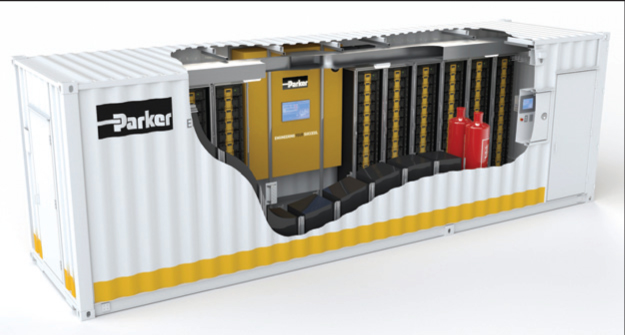
Battery-based systems are rapidly gaining market share. These consist of two main parts – a bank of batteries and a power conversion system (PCS) used to interface the batteries to the grid. The battery bank is the battery management system that monitors battery condition, charge rate and other variables. Its function is to report back to the PCS or energy management system when a battery-related anomaly occurs. The battery bank system by Hannifin uses a series or parallel arrangements of battery cells in order to obtain the required terminal voltage for highest efficiency and required storage capacity. It also uses a bidirectional PCS with high-speed, insulated-gate bipolar transistor to help switch and provide full power delivery in either direction within milliseconds. The system also provides automated sequenced shutdown and disconnection in power loss situations, and can be configured to function in island mode, providing backup power for an isolated microgrid. Some of the systems can provide both real and reactive power, which enables a battery energy storage system (BESS) to truly support the grid and withstand grid faults. Firmware and programmability in the PCS can allow for flexibility of control and standalone operation. If PCS contains the algorithms for real and reactive power management, it can eliminate or reduce the responsibility of external site management by the utility company, bringing about cost, technical and logistical benefits. In addition, keeping the harsh and challenging operating environment in mind, BESS systems are developed with refrigerants such as R134a, which is circulated in the BESS system at high pressure for thermal management. As heat from the components gets transferred to the refrigerant, it partially evaporates and the resultant vapour is sent to a condenser. The vapour then condenses into liquid and returns to the holding reservoir, where it is again pumped through the components, making the whole procedure efficient and effective. The technical capabilities and benefits of BESS can address the multiple aspects of power quality and storage. It can compensate for peak loading with a high-energy discharge through the PCS within a second. It can also help in keeping a stable ramp rate and capacity firming. Thus, a BESS system, with its advanced battery design and sturdy construction, can help manufacturers improve the efficiency and lifespan of the system, as well as enhance the safety of the grid.
By David Blood, Market Manager EMEA, Energy Grid-Tie Division, Parker Hannifin
